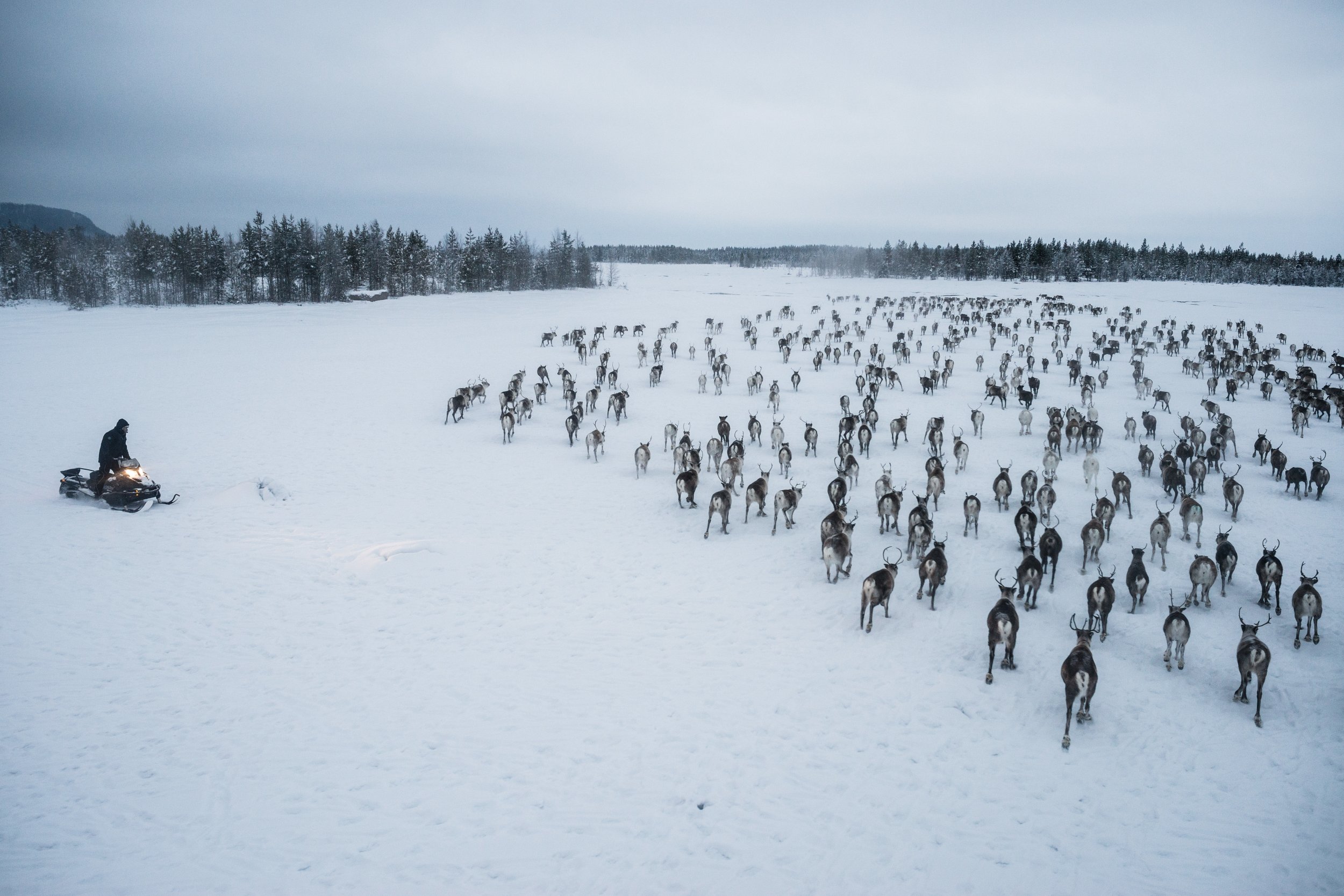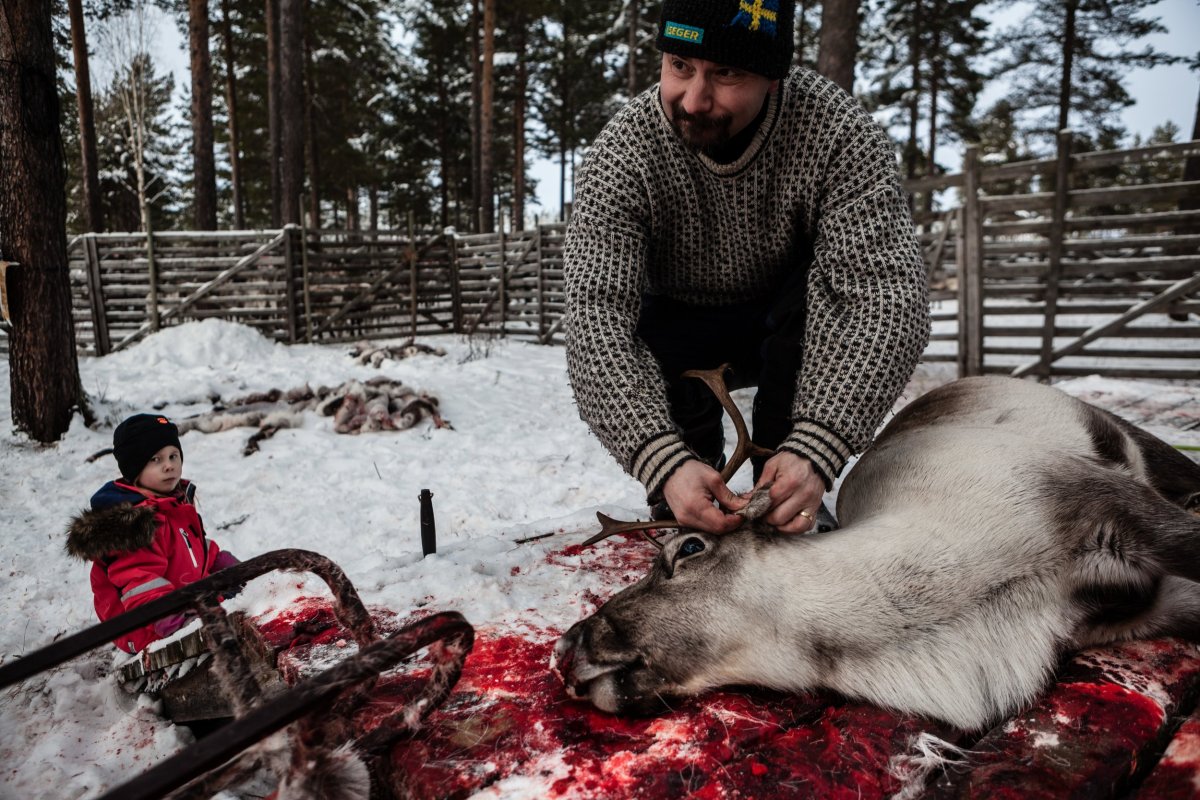
It is Sara Aleksandersen's job to stir the blood. As Issat Turi, her uncle, cuts up the reindeer he has just slaughtered with a knife stroke to the throat, she kneels down, the cream of her reindeer-skin coat only a few shades darker than the snowy tundra around her. Sara is 15, and like generations of Sami youngsters before her, it is her responsibility to keep the blood in the bucket moving, to prevent the precious crimson fluid from coagulating. "For us, the reindeer is everything," says Turi. "We don't waste a bit."
For the 100,000 indigenous people—of 24 different ethnicities and nationalities—who make a living herding in the Arctic Circle, reindeer are not a cute seasonal accessory. Instead, they are everything: food, clothing, transportation, timepiece, livelihood, culture. But as pressures such as climate change and industrialization mount, reindeer herders living in the far reaches of the north find their traditional way of life increasingly under threat—which is why a group of them, operating out of the International Centre for Reindeer Husbandry (IRC), are mounting an extraordinary international effort to protect it.
Modern Changes
The IRC and other Arctic organizations recognize that many of the challenges herders face, especially for those in the eastern Arctic, are related to climate change. Rising temperatures and shorter winters mean that instead of snow, winter precipitation often falls as rain, which refreezes as a layer of ice that prevents reindeer from accessing the lichen that constitutes the bulk of their winter diet. The effect isn't uniform: On the Svalbard Islands, receding ice has contributed to a rise in the local reindeer population. But globally, the number of animals has diminished roughly 30 percent in the past 10 to 15 years. In Russia, it's even worse: Reindeer stocks in the Taymyr Peninsula have declined by 40 percent since 2000, and an anthrax outbreak in Siberia, born of melting permafrost, recently killed 1,500 reindeer.
As once-frozen landscapes defrost, they also become more appealing to nonindigenous humans. In many parts of the Arctic, industry and even conventional agriculture are now encroaching on grazing lands that herders have depended on for more than a thousand years. In Mongolia, miners have destroyed some reindeer habitats in their quest for gold. In Siberia, new roads designed to provide quick access have disrupted migration routes.
These changes are less apparent in the western Arctic, though they do exist. In northern Finland, for example, forestry is becoming more efficient, resulting in sparser foliage of the sort that reindeer need to eat. And in Norway, receding ice has likewise brought new industries—mining, wind farming, hydroelectric dams—to the coastal areas of the northernmost Finnmark region and has even led to the growth of conventional animal husbandry in the area, which means greater competition for habitats.
But so far, climate-related changes in Scandinavian herding areas have been modest. More worrying, according to the Sami, who herd the great majority of the country's roughly 200,000 reindeer, are the forms of government intervention.
In the past, the Sami butchered reindeer at home and in seasons that varied according to the animals' gender and age. But as Norwegians' taste for reindeer meat has grown—the average annual consumption is 400 grams per person—the government has largely taken control of the killing and butchering of reindeer, monopolizing distribution networks and requiring that any meat for public sale be prepared in industrial slaughterhouses. The industrialization of the process has tended to drive down prices for reindeer meat. And while the government has compensated herders with subsidies, it pays only for any calves that are killed; the Sami don't usually kill and eat calves in large numbers since they are necessary for maintaining the herd's size.
"Now it's the meat monopoly controlling those things," says Anders Oskal, executive director of the ICR, which is located in the northern Norwegian city of Guovdageaidnu. "And if we don't practice them ourselves, we're in danger of losing our traditional knowledge."
The Reindeer Resistance
With his lush mustache and royal blue tunic adorned with grosgrain ribbons and heavy silver brooches, Oskal bears a certain resemblance to the Emerald City gatekeeper in The Wizard of Oz. But rather than keeping anyone out, he is dedicated to bringing them in. At the ICR, he oversees a course of study that teaches indigenous young people about everything from traditional slaughter and cooking methods to biodiversity and legal rights. "Our focus isn't on training people so they can leave our society. We're teaching them what they need to stay in our society."
By "our" he means not just Sami culture but that of all reindeer herders. One of the IRC's missions is to bring together the north's indigenous people so they might preserve and exchange traditional knowledge. Earlier this year, for example, members of a dozen different herding groups met at the center's campus for a biodiversity course that started with a cooking session. Members of each group prepared their native recipes: Evenki women from northern Asia made reindeer throat sausage (the larynx acts as a casing for a filling of eyes and lips); a Nenets law student from the Russian Arctic prepared a typical dish of raw liver in fresh blood; and a Sami cook boiled hooves until their cartilage turned nearly liquid, then set them upright in a bowl so they looked like freshly steamed mussels. (They did not, it must be said, taste of them.)
For 23-year-old Ganbold Bayarmagnai, who came from Mongolia and wore a lustrous quilted coat while baking bread made with reindeer milk over an open fire, it was a rewarding experience. "At home, our eternal snow mountain no longer has snow. Our eternal frozen lakes are no longer frozen," he says. "But this makes me feel like we'll survive."
The ICR is making other efforts to ensure that Bayarmagnai is right. In late November, Oskal traveled to Yakutsk in Siberia to participate in a seminar on using technology to protect the reindeer meat industry. The center is also compiling an international cookbook of reindeer herders' recipes, in order to help preserve traditional culinary practices. And it works with the Arctic Council, a high-level organization comprising eight member states and representatives from the circumpolar area's indigenous peoples, to recognize and use herding communities' traditional knowledge in its climate-change adaptation strategies.
Many Sami, who in the 1960s began herding with snowmobiles instead of the traditional skis and sled, are open to change when they believe it makes sense. Issat Turi, who spends most of the year on the tundra living near his herd in an isolated house that is a 90-minute ride by snowmobile from Guovdageaidnu, brings his reindeers' carcasses to the industrial slaughterhouse to sell, even though, he says with a disbelief that borders on contempt, "they waste so much. The blood, the bones, the skin? They don't want that. Just the meat."

At the beginning of December, Turi used trucks to move his herd from its summer grazing land on an island 500 kilometers away from his home. And he has plans to introduce his traditionally raised and slaughtered reindeer meat to some of those restaurants in Copenhagen and Oslo that he knows are interested in sustainably raised local products.
But he still loves the old ways. He kills the animals that he and his family consume and smokes the flesh over an open fire in a lavvu, the Sami dwelling made from branches and reindeer skins. He likes sitting by a fire at night, opening a beer and listening to a joik, a haunting song form meant to evoke a person or place. And although it is considered rude to ask a Sami herder how many reindeer he has, and hubristic for the herder to answer, Turi says he is doing well enough that he doesn't worry about the future (although he studied carpentry in school, just in case).
A generation younger, his niece Sara is less certain. Like most Sami today, she lives a life that straddles the modern and traditional: She goes to school in Guovdageaidnu, dresses mostly in jeans and sweaters, and enjoys tacos and chicken as much as reindeer meat. Because she has an older brother, she won't inherit her father's herd (which is separate from Turi's) and says she might become a teacher instead. But she handles a snowmobile like a pro, and her cover photo on Facebook is of her family's herd.
As she stirs the blood that will be turned into sausage, she acknowledges that herding is a hard life. "A lot of my friends don't want to do it because it's so difficult," she says. "But I like it. You have a kind of peace out here that you don't feel in the city. Plus," she adds, gesturing toward the reindeer, "this is who we are."
Uncommon Knowledge
Newsweek is committed to challenging conventional wisdom and finding connections in the search for common ground.
Newsweek is committed to challenging conventional wisdom and finding connections in the search for common ground.
About the writer
To read how Newsweek uses AI as a newsroom tool, Click here.








